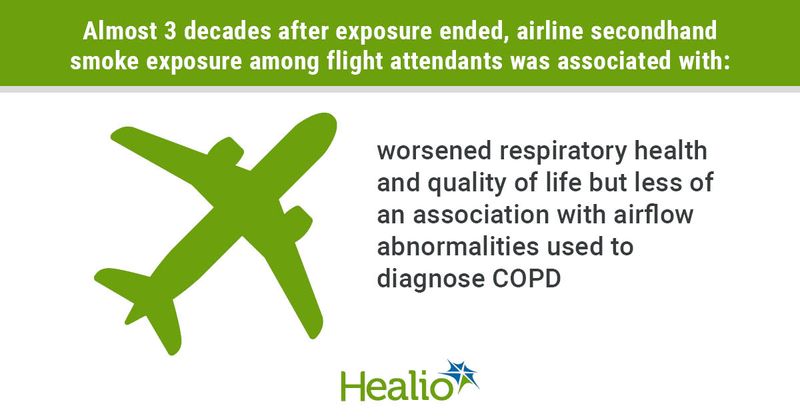Airline secondhand smoke exposure tied to worsened respiratory health decades later
Secondhand tobacco smoke exposure on airlines was strongly associated with worse respiratory health nearly 3 decades after exposure, researchers reported in Chest.
“From the 1930s through the 1990s, predominantly female flight attendants, hired in their 20s, were involuntarily exposed to high concentrations of airline secondhand smoke that were about 14 times greater than for the average person and more than six times greater than for the average worker. High concentrations of secondhand smoke were caused by the high density of smokers, small available airspace per person, inadequate outside air ventilation that decreased over time, and the proximity of flight attendants to passengers, especially during mealtime when smoking increased,” Fernando Diaz Del Valle, MD, professional research associate in the department of environmental and occupational health in the division of pulmonary sciences and critical care medicine at the Colorado Pulmonary Outcomes Research Group at the Colorado School of Public Health, Aurora, and colleagues wrote. “Exposure of flight attendants to airline secondhand smoke was comparable to exposures that continue to occur today in casinos, bars, nightclubs, automobiles and even in the home, making the findings from this study relevant to people living in regions that lack public smoking bans, as well as those who continue to be exposed in family homes and vehicles.”

The researchers conducted a prospective cohort study to evaluate the effects of airline secondhand smoke exposure on respiratory health and lung function decades after it was stopped. The study included 183 secondhand tobacco smoke-exposed participants (mean age, 66.7 years; 90.7% women) and 59 unexposed participants (mean age, 63.2 years; 74.6% women) who were flight attendants over 20 years prior. Participants were hired at airlines at an average age of 23.8 years and were exposed to airline secondhand tobacco smoke for an average of 16.1 years, with 27.5 years without exposure before study enrollment.
The primary outcome was respiratory quality of life as measured by the St. George’s Respiratory Questionnaire. Secondary outcomes included general quality of life, respiratory symptoms and spirometry.
Prior exposure to secondhand tobacco smoke was associated with worsened respiratory quality of life (P = .001), Short Form-36 Health Survey Questionnaire physical function (P = .01) and social function (P = .004), and COPD Assessment Test score (P = .0002) compared with unexposed participants. Secondhand smoke exposure did not impact pre-bronchodilator spirometry or airway obstruction; however, secondhand smoke exposure was associated with lower post-bronchodilator FEV1 (P = .03) and FEV1/FVC (P = .03), total lung capacity (P = .053) and diffusing capacity of the lungs for carbon monoxide (P = .02).
A history of former smoking and secondhand tobacco exposure collectively worsened respiratory quality of life (P = .04). In addition, secondhand tobacco smoke exposure among never smokers had the same primary results and was also associated with worse respiratory quality of life compared with unexposed participants (P = .006), according to the researchers.
“Prior studies have shown that active secondhand smoke exposure is associated with worsened quality of life, increased respiratory symptoms and a small decrement in lung function. Our study strengthens and extends these findings by demonstrating that airline secondhand smoke exposure is associated with similar effects on respiratory quality of life, general quality of life and symptoms almost three decades after exposure stopped,” the researchers wrote.
Diaz del Valle and colleagues said further research is warranted.
“Future studies should focus on the clinical and biological impact of secondhand tobacco smoke-induced COPD with preserved lung function, as has been done for people who smoke,” the researchers wrote. “It is hoped that a better understanding of the long-term impact of secondhand tobacco smoke exposure will encourage medical providers to ask important questions that are not currently being asked about the extent of their patients’ exposure to secondhand tobacco smoke, and legislative bodies to enact more stringent public measures to protect people who do not smoke from involuntary exposure to secondhand tobacco smoke.”
